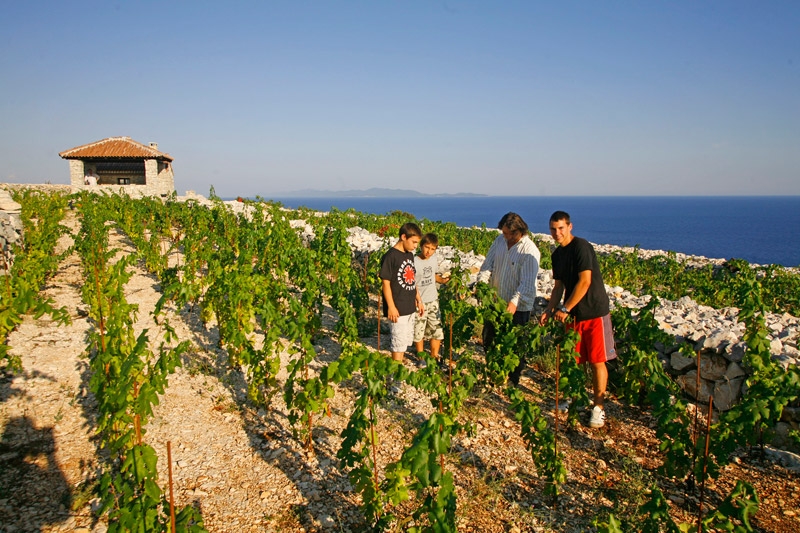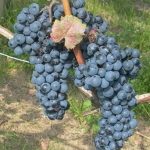 Grk is a close relative to Tribidrag, a parent of Plavac Mali
Whoever planted the Plavac variety in Lumbarda? The wines are no good. This is how, legend says, cried out a wine grower from this village on Korčula island in southern Dalmatia, seeing how vines of the unwanted Plavac occupy space for Grk, a historically famous variety which gives excellent white wines on the local sandy soil. So he pulled out the Plavac. He was satisfied only until the next summer, when the grapes were tiny and without seeds. There was no pollination as Grk is a variety which cannot pollinate itself. The flower does have both organs, but the male ones are undeveloped and bent downwards, so there is no self pollination. Clearly the next year the Plavac was returned.
It is unclear why through history Plavac was used as a pollinator as the two varieties bloom in different periods. Besides, their love could be called an incest. Grk is a close relative to Tribidrag, a parent of Plavac Mali.
Modern genetics managed to prove this, but ampelographers, experts in grape varieties, failed to find the origin of Grk.
Some consider it one of the first varieties Greek settlers brought to Dalmatia, others that the name came from the characteristically pleasant bitter taste of wine. Also, historically everything old and of unknown origin on the Croatian coast was attributed to the Greeks.
This Grk is special, even specially valuable, as it grows on sandy soil, so part of the vines survived phylloxera, which devastated Italian and French vineyards in the end of the 19th century, Croatian ones in the beginning of the 20th century. The consequences were especially terrible on Dalmatian islands whose inhabitants lived off grapes and wine. Without vines, they began to emigrate overseas. And Grk got hurt. It was once among the leading white varieties in Dalmatia, currently at just over 15 hectares. Other than Lumbarda, it can be sporadically found in the Dubrovnik coast and on islands Šipan, Mljet and Pelješac peninsula. But better times are ahead.
Primarily because it was included in the programme of clone and sanitary selection whose aim is to create preconditions for a higher quality reproduction of the variety. A smaller master plantation was created in the Baštica area near Zadar, with the first certified vines already produced.
Cebalo and Zure are labels which slowly but surely are taking over the market, while Frane Milina Bire has a faithful following which trembles each year in advance of the new harvest of his Grk in a plump Burgundy bottle. Bire is important for the Grk as, besides the sand in Lumbarda, he grows the variety on the karst position Defora. His terraces bordered by stone remind of the famous Primošten wine growing lace, while his Grk Defora has achieved cult status although it is not on the market. It is poured in his cellar and at fairs and festivals, under the counter. And with every new glass the legend gets a new chapter.
For the original and more from Vino.hr blog on wine, click here.
Grk is a close relative to Tribidrag, a parent of Plavac Mali
Whoever planted the Plavac variety in Lumbarda? The wines are no good. This is how, legend says, cried out a wine grower from this village on Korčula island in southern Dalmatia, seeing how vines of the unwanted Plavac occupy space for Grk, a historically famous variety which gives excellent white wines on the local sandy soil. So he pulled out the Plavac. He was satisfied only until the next summer, when the grapes were tiny and without seeds. There was no pollination as Grk is a variety which cannot pollinate itself. The flower does have both organs, but the male ones are undeveloped and bent downwards, so there is no self pollination. Clearly the next year the Plavac was returned.
It is unclear why through history Plavac was used as a pollinator as the two varieties bloom in different periods. Besides, their love could be called an incest. Grk is a close relative to Tribidrag, a parent of Plavac Mali.
Modern genetics managed to prove this, but ampelographers, experts in grape varieties, failed to find the origin of Grk.
Some consider it one of the first varieties Greek settlers brought to Dalmatia, others that the name came from the characteristically pleasant bitter taste of wine. Also, historically everything old and of unknown origin on the Croatian coast was attributed to the Greeks.
This Grk is special, even specially valuable, as it grows on sandy soil, so part of the vines survived phylloxera, which devastated Italian and French vineyards in the end of the 19th century, Croatian ones in the beginning of the 20th century. The consequences were especially terrible on Dalmatian islands whose inhabitants lived off grapes and wine. Without vines, they began to emigrate overseas. And Grk got hurt. It was once among the leading white varieties in Dalmatia, currently at just over 15 hectares. Other than Lumbarda, it can be sporadically found in the Dubrovnik coast and on islands Šipan, Mljet and Pelješac peninsula. But better times are ahead.
Primarily because it was included in the programme of clone and sanitary selection whose aim is to create preconditions for a higher quality reproduction of the variety. A smaller master plantation was created in the Baštica area near Zadar, with the first certified vines already produced.
Cebalo and Zure are labels which slowly but surely are taking over the market, while Frane Milina Bire has a faithful following which trembles each year in advance of the new harvest of his Grk in a plump Burgundy bottle. Bire is important for the Grk as, besides the sand in Lumbarda, he grows the variety on the karst position Defora. His terraces bordered by stone remind of the famous Primošten wine growing lace, while his Grk Defora has achieved cult status although it is not on the market. It is poured in his cellar and at fairs and festivals, under the counter. And with every new glass the legend gets a new chapter.
For the original and more from Vino.hr blog on wine, click here.
Do you want to try Croatian wines?
If you want to savor the exquisite flavor of Croatian wines, look no further than wineandmore.com. Offering a wide range of wines from various winemakers, you can easily find what suits your palate.
Do you need help selecting the right wine bottle? Try one of their curated wine cases, and find the perfect vintage for any occasion!











